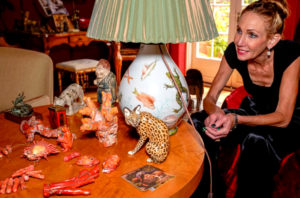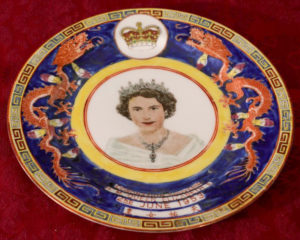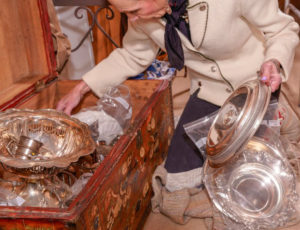For 30 years I’ve visited people’s home environments, and I can tell their ‘material psychology’ by observing their home. Not only that, I can suss out a person’s attachment style to objects when I’m asked to appraise something. Here are a few examples of styles of ‘ownership’:
 “I have inherited good stuff, but I haven’t looked at it since mom died. Let me tell you about the collection,” said DS, a woman of about 70. She then tells me, not about the stuff, but about how Mom appears in the objects. “Mom loved her great hats and wore even the most extravagant no matter how they embarrassed us. She loved those long ropes of pearls, which I hate.” At this point, I hear about Mom’s special clubs, her outfits, and her fights with her interior designers back in Cleveland. “Mom loved her artist friends and collected terrible art which she spent thousands on framing. I can’t stand amateur art.” The story? I went to see mom’s objects, and I have now been to see the same objects a few times, each time with a plan for auction sales, donations, heirship ideas. My client has yet to make up her mind to say ‘goodbye.’ This is an attachment style based on a past (and not so pleasant) history. To give up the objects means in some way to give up that grudge.
“I have inherited good stuff, but I haven’t looked at it since mom died. Let me tell you about the collection,” said DS, a woman of about 70. She then tells me, not about the stuff, but about how Mom appears in the objects. “Mom loved her great hats and wore even the most extravagant no matter how they embarrassed us. She loved those long ropes of pearls, which I hate.” At this point, I hear about Mom’s special clubs, her outfits, and her fights with her interior designers back in Cleveland. “Mom loved her artist friends and collected terrible art which she spent thousands on framing. I can’t stand amateur art.” The story? I went to see mom’s objects, and I have now been to see the same objects a few times, each time with a plan for auction sales, donations, heirship ideas. My client has yet to make up her mind to say ‘goodbye.’ This is an attachment style based on a past (and not so pleasant) history. To give up the objects means in some way to give up that grudge.- Another attachment style is the “I don’t care about stuff” style, which is most prevalent with under 40 year-olds. Younger clients of mine want to live without clutter. However, there’s plenty of electronic clutter in the shape of technology and cords and chargers in the house. These clients make a distinction between clutter of the past and the ‘clean’ clutter of the 21 century. They CARE about stuff, just not about the stuff they don’t like.
- Then I see the collector mentality. Everything is potentially valuable because it came from a collection owned by a relative
 or, sometimes even themselves. I call this attachment style the “endowment effect.” Because Dad, or even Mr DuPont, had possessed it. It means more than if someone else had possessed the same object. This style indicates a strong tie to the symbolic grasp of a real person behind the object, based on that person’s status. One item in a collection is worth more because the original owner never possessed an item worth ‘nothing.’ MUCH research and time goes into proving that not everything is valuable.
or, sometimes even themselves. I call this attachment style the “endowment effect.” Because Dad, or even Mr DuPont, had possessed it. It means more than if someone else had possessed the same object. This style indicates a strong tie to the symbolic grasp of a real person behind the object, based on that person’s status. One item in a collection is worth more because the original owner never possessed an item worth ‘nothing.’ MUCH research and time goes into proving that not everything is valuable. - At the top of the heap is the connoisseur style of attachment. My connoisseurs are attached to objects because they TEACH them something. Through the objects, they learn about history, about social morals, about economics, about the medium, of which these things are made. These folks will happily sell an object that offers no intellectual journey for them. And part of the intellectual journey is the pursuit of their developing sense of ‘beauty’, a personal measure.
 Finally, I observe the “orphan” attachment style. Some of my clients attach an object to themselves because nobody else wanted it. These people find glory in cast off unsigned oil paintings (this is ME), and the sculptures which didn’t hang together quite right. These folks buy something broken, so they can try to bring it back to life. They search the thrift stores for possibilities in an object. “Maybe if I refinish it, it’ll be worth something. If I re-stitch it, it’ll fit me. If I stretch those boots, they’ll go over my calves.” That’s the orphan attachment style. It says, “I am a person who notices the outcasts, and sees the potential in all things.” I recognize these people by their projects with stuff ongoing in the back yard and in the garage.
Finally, I observe the “orphan” attachment style. Some of my clients attach an object to themselves because nobody else wanted it. These people find glory in cast off unsigned oil paintings (this is ME), and the sculptures which didn’t hang together quite right. These folks buy something broken, so they can try to bring it back to life. They search the thrift stores for possibilities in an object. “Maybe if I refinish it, it’ll be worth something. If I re-stitch it, it’ll fit me. If I stretch those boots, they’ll go over my calves.” That’s the orphan attachment style. It says, “I am a person who notices the outcasts, and sees the potential in all things.” I recognize these people by their projects with stuff ongoing in the back yard and in the garage.